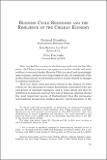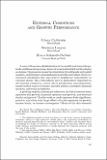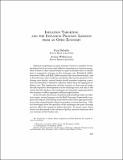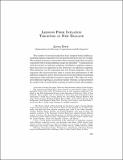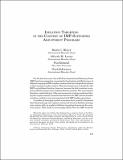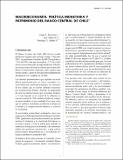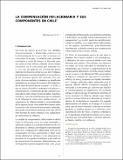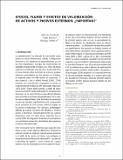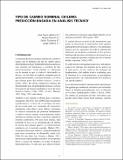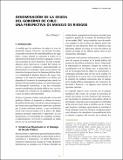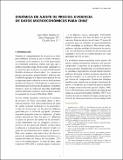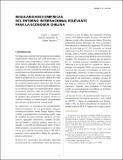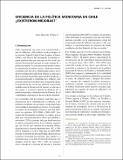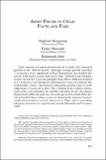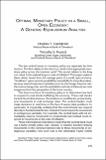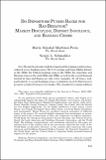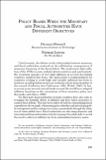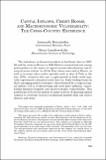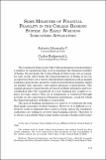Buscar
Mostrando ítems 41-60 de 1137
Business cycle responses and the resilience of the chilean economy
After marked fluctuations in the business cycle over the last fifty years, the Chilean economy now appears to be less volatile and more resilient to external shocks. Because Chile is a small and increasingly open economy, analysts have long suspected that the amplitude of the cyclical fluctuations in ...
External conditions and growth performance
A central dimension of globalization is the world trend toward larger trade and financial openness, observed in most industrial and developing economies. Openness increases the integration of world goods and capital markets, contributing to potential gains in growth and welfare. However, increased ...
Inflation targeting and the inflation process: lessons from an open economy
Inflation targeting in an open economy insolves a number of complexities that do not arise with inflation targeting in a clises economy. One of these is that central banks in open economies have to decide how to repond to changes in the exchange rate.
Lessons from inflation targeting in New Zealand
The number of central banks that have adopted formal inflation targeting regimes expanded over the past decade from only one to eight. The number increases even further when central banks that set policy consistent with a formal inflation target are included. Commesurate with the formal or informal ...
Inflation targeting in the context of IMF-Supported adjustment programs
For the last few years, the staff of the Iternational Monetary Fund (IMF) has been engaged in assessing the functioning and effectiveness of inflation targeting in IMF member countries that have adopted this scheme as their monetary policy anchor. This involvement was restricted to the IMF's surveillance ...
Macroeconomía, política monetaria y patrimonio del Banco Central de Chile
En este artículo se hacen proyecciones estocásticas del balance (saldos y flujos) del Banco Central de Chile, a partir de su situación deficitaria actual. Estas proyecciones incorporan el efecto que tienen sobre el balance algunas variables macroeconómicas y políticas alternativas y dan cuenta de la ...
La compensación inflacionaria y sus componentes en Chile
Este documento estudia los determinantes de los componentes de la compensación inflacionaria definida como la diferencia que existe entre las tasas de interés nominales e indexadas. Lo anterior permite evaluar cuánto inciden estos en las elecciones de portafolio de los agentes económicos y, por lo ...
Stocks, flujos y efectos de valorización de activos y pasivos externos: ¿importan?
La reciente integración financiera internacional se ha caracterizado por el incremento en las posiciones de activos y pasivos externos y una creciente relevancia de los efectos de valorización (ganancias o pérdidas de capital). En este trabajo evaluamos empíricamente las implicancias de stocks, flujos ...
Tipo de cambio nominal Chileno: predicción basada en análisis técnico
Este trabajo presenta un resumen de las principales medidas utilizadas en el análisis técnico de la paridad peso-dólar. Se explica la interpretación y el uso que los analistas técnicos dan a estas medidas. Asimismo, se realizan ejercicios que evalúan la capacidad del Índice de Fuerza Relativa (RSI) ...
Denominación de la deuda del gobierno de Chile: una perspectiva de manejo de riesgos
Este trabajo propone un marco de análisis para evaluar la conveniencia de la denominación actual de la deuda del Gobierno Central de Chile, a través del efecto en el riesgo asociado al resultado fiscal. Se propone una metodología tipo VaR (Valor en riesgo) para comparar denominaciones alternativas de ...
Cuenta corriente y financiamiento externo
Este trabajo muestra un resumen integrado de los aspectos más sobresalientes de los trabajos presentados en la décima Conferencia Anual del Banco Central de Chile 'Cuenta Corriente y Financiamiento Externo', realizada en noviembre de 2006 y por aparecer compilados en un libro de próxima publicación. ...
Dinámica de ajuste de precios: evidencia de datos microeconómicos para Chile
Este trabajo caracteriza la dinámica de ajustes de precios en Chile usando datos a nivel de establecimientos para los productos de la canasta del IPC. Nuestros resultados muestran que las rigideces nominales son más bajas cuando están medidas a nivel microeconómico que cuando están estimadas con datos ...
Regularidades empíricas del entorno internacional relevante para la economía Chilena
En el presente estudio se analizan regularidades macroeconómicas dentro de los grandes bloques económicos (EE.UU., Europa y Japón) y se describe la interacción entre variables relevantes de estos bloques y su relación con variables de interés para la economía Chilena como precios de productos básicos, ...
Eficiencia de la política monetaria en Chile ¿existieron mejoras?
La volatilidad del producto y de la tasa de inflación disminuyó de manera importante en los últimos años. Esta mejora del desempeño económico se puede explicar tanto por una caída de los shocks que enfrenta la economía como por una mejora en la política monetaria. Este documento explora la contribución ...
Asset prices in Chile: facts and fads
Chile enjoyed an unprecedent period of rapid and sustained growth in the 1986-98 period. Although average growth exceeded 7.1 percent a year, significant cyclical fluctuations also marked the period, both across sectors and across time. Growth in the tradable sectors exceeded 6.7 percent annually from ...
Optimal monetary policy in a small, open economy: a general-equilibrium analysis
The two central issues in monetary policy are separated by time horizon. The first relates to the short run: what is the appropriate monetary policy across the business cycle? The second relates to the long run: waht is the optimal long-run rate of inflation? This paper explores these classic issues ...
Do depositors punish banks for bad behavior? market discipline, deposit insurance, and banking crises
Over the last two decades, both developed and developing countries have endured severe banking crises. The U.S. savings and loans (S&Ls) debacle in the 1980s, the chilean banking crisis in the 1980s, the Argentine and Mexsican crises in the mid-1980s and 1990s, as well as the recent financial turmoil ...
Policy biases when the monetary and fiscal authorities have different objectives
Until recently, the debate on the relationship between monetary and fiscal authorities centered on the inflationary consequences of mentary financing of the fiscal deficit. The moderately high inflation of the 1970s in some industrialized countries and, particularly, the recurring episodes of very ...
Capital inflows, credit booms, and macroeconomic vulnerability: the cross-country experience
The turbulence in financial markets is Southeast Asia in 1997-98 and the crisis in Mexico in 1994-95 have renewed interest among policymarkers in the issues of capital account liberalization and financial sector reform. In all the East Asian cases and in Mexico, as well as in many other earlier episodes ...
Some measures of financial fragility in the chilean banking system: an early warning indicators application
The regulatory framework of the chilean financial system includes a number of regulations that seek to maintain the financial stability of banks. On one hand, the Central Bank of Chile in its role as regulator and, on the other hand, the Superintendency of Banks in its role as supervisor have set a ...

